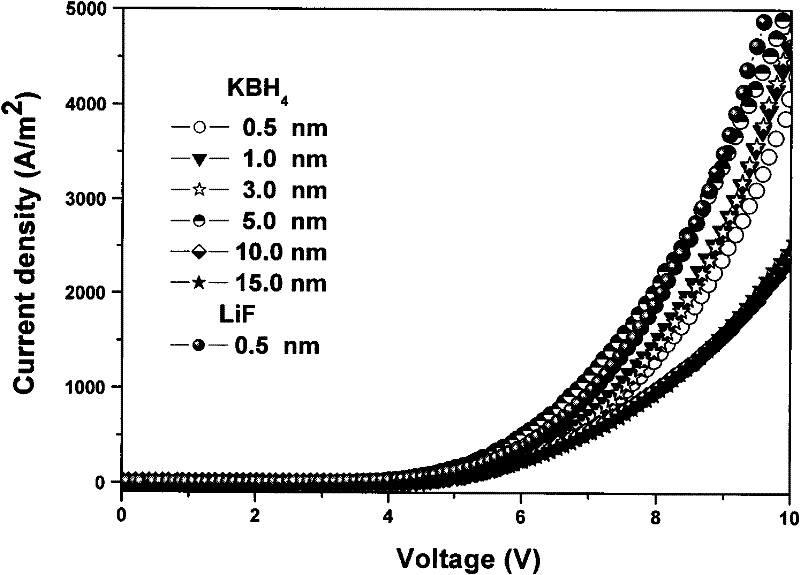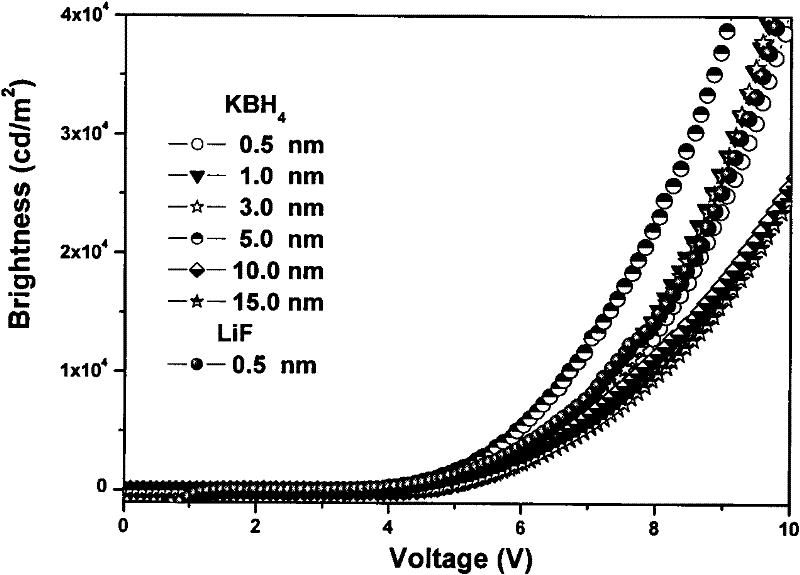Organic electroluminescent device and manufacturing method thereof
An electroluminescent device and electroluminescent technology, which are applied in the fields of electro-solid devices, chemical instruments and methods, semiconductor/solid-state device manufacturing, etc. Hole balance, low electron injection barrier, effect of lowering injection barrier
- Summary
- Abstract
- Description
- Claims
- Application Information
AI Technical Summary
Problems solved by technology
Method used
Image
Examples
Embodiment 1
[0036] refer to figure 1 , is a cross-sectional view of the structure of the organic electroluminescent device of this embodiment, wherein the substrate 10, the anode layer 20, the hole transport layer 30, the light emitting layer 40, the cathode modification layer 50 and the cathode layer 60. The preparation structure of the organic electroluminescent device in the embodiment of the present invention is as follows:
[0037] Glass substrate / ITO / NPB(50nm) / PADN: 1.5% C545T(30nm) / Alq 3 (30nm) / KBH 4 ((0.5nm) / Al(150nm)
[0038] 1) Preparation of organic light-emitting layer
[0039] Place the pretreated glass substrate in a vacuum chamber and evacuate to 1×10 -3 Pa, the hole transport material NPB is evaporated, the evaporation rate of the material film is 0.1nm / s, and the film thickness is 50nm to form a hole transport layer; 30nm thick PADN is sequentially evaporated on the hole transport layer: 1.5% C545T is used as the light-emitting layer of the device, and 30nm thick Alq...
Embodiment 2
[0047] The structural sectional view of the organic electroluminescent device of this embodiment is the same as that of Embodiment 1, such as figure 1 shown. The preparation structure of the organic electroluminescent device in the embodiment of the present invention is as follows:
[0048] Glass substrate / ITO / NPB(50nm) / PADN: 1.5% C545T(30nm) / Alq 3 (30nm) / KBH 4 ((1.0nm) / Al(150nm)
[0049] The preparation method is the same as in Example 1, except that the film thickness of the cathode modification layer in this example is 1.0 nm.
Embodiment 3
[0051] The structural sectional view of the organic electroluminescent device of this embodiment is the same as that of Embodiment 1, such as figure 1 shown. The preparation structure of the organic electroluminescent device in the embodiment of the present invention is as follows:
[0052] Glass substrate / ITO / NPB(50nm) / PADN: 1.5% C545T(30nm) / Alq 3 (30nm) / KBH 4 (3.0nm) / Al(150nm)
[0053] The preparation method is the same as in Example 1, except that the film thickness of the cathode modification layer in this example is 3.0 nm.
PUM
| Property | Measurement | Unit |
|---|---|---|
| Sheet resistance | aaaaa | aaaaa |
| Film thickness | aaaaa | aaaaa |
| Thickness | aaaaa | aaaaa |
Abstract
Description
Claims
Application Information
 Login to View More
Login to View More - R&D
- Intellectual Property
- Life Sciences
- Materials
- Tech Scout
- Unparalleled Data Quality
- Higher Quality Content
- 60% Fewer Hallucinations
Browse by: Latest US Patents, China's latest patents, Technical Efficacy Thesaurus, Application Domain, Technology Topic, Popular Technical Reports.
© 2025 PatSnap. All rights reserved.Legal|Privacy policy|Modern Slavery Act Transparency Statement|Sitemap|About US| Contact US: help@patsnap.com



